Bomber_12th
SOH-CM-2025
First off, while I do have some more 'flashy' navy blue Corsair repaints to make, I wanted to make a repaint of my favorite Corsair restoration first. Some of the following information comes from the November/December 2010 issue of Warbird Digest. This repaint is for the Aircraft Factory F4U-1A Corsair.
This repaint set depicts Goodyear FG-1D Corsair BuNo. 92489, from its debut at Oshkosh in 2010 following the completion of its award-winning restoration, and through its various slight changes in the years since (4 different options in all). This aircraft's survival is due to the efforts of Frank Arrufat, who purchased the aircraft from the Salvadorian AF in 1972. Frank, who was 32 at that point, was an ex-Navy pilot and an up-and-coming junior airline pilot working for TWA. An ad in Trade-A-Plane provided the news of the sale of surplus Corsairs in El Salvador, and Frank was able to hitch a ride on one of his company's aircraft to Ilopango Airport in San Salvador to ascertain what was available. After inspecting all of the Corsair airframes available, Frank decided on what was the least worse off and most complete of the Corsairs, FAS 209 (all of the Corsairs were incomplete, many lacking engines and with their outer wings detached). Frank drew up a laundry list of parts that his Corsair was missing and over the next two years he traveled back and forth to visit the airport, and through the help of personnel from the Salvadorian AF, worked on scavenging the needed parts from the other Corsairs on the field. In early 1974, with all of the needed parts found, the aircraft was finally disassembled and shipped to the U.S. - after the last of the payments, Frank had a complete Corsair project for $4,000. Due to being busy with work and starting a family, Frank wasn't able to get started on restoring the Corsair until 1983, basing the project at Fabens airstrip, an agricultural field, in El Paso, Texas. Over the next 17 years, Frank invested roughly 6,500 man-hours to restore the Corsair to airworthy. In 2000, Frank retired and began looking at the possibilities of fast-tracking the project to completion, and decided to send the project to John Lane's company, Airpower Unlimited in Jerome, Idaho (experts in authentic Corsair rebuilds) for completion. The plan that Frank had for the aircraft was followed through with precision - although a late-built FG-1D, Frank wanted the aircraft to resemble an F4U-1A or a very early F4U-1D Corsair, from the late-1943 to early-1944 period, a time when Corsairs were earning their keep, operating from crude land bases in the South Pacific. The feeling at the time was that there wasn't a Corsair flying that truly captured the essence of those early combat F4U's, and that restoring BuNo. 92489 in this fashion would set it apart. The transfiguration meant incorporating visual cues such as a tri-color camouflage paint scheme, an early style double-braced canopy, a slightly different antenna arrangement, amongst other detail alterations (including the fitting of an early factory-built Brewster center-line bomb rack). In 2009, with the Corsair on the verge of completion, Frank was faced with the hard fact that he was no longer able to justify spending more money on the project, and was willing to entertain offers from willing investors. Of a number of potential buyers, John O'Connor was the one to purchase the aircraft. Having fallen in love with the aircraft after having been introduced to the project in 2009, he set about having it completed just as Frank had intended, even including the name Kathleen on the nose, in honor of Frank's wife, and the registration number N209TW signifying FAS number 209 and Frank's previous employer, Trans World Airlines.
The plan from the moment John O'Connor purchased the aircraft was to have it completed in-time to debut at Oshkosh Airventure in 2010. Airpower Unlimited literally labored on the aircraft until the last moment to get the aircraft ready in time. With just enough flight testing conducted, John Lane headed to Oshkosh on the Monday of the show, but ran into a couple of engine problems upon nearing the first stop on the flight there. Waiting on a part, it wasn't until two days later that John Lane was able to make it into Oshkosh, late in the day, where Frank Arrufat and his wife Kathy were expectantly waiting as it rolled up in the warbird parking - when it showed up, it was a major surprise for those at the show and for those following the warbird forums at the time. Arriving just before the warbird judging was completed, the aircraft took home that year's World War Two Grand Champion award (amongst some stiff competition).
For the first version of this repaint, here is a depiction of what the aircraft looked like following completion of restoration by Airpower Unlimited and debuting at Oshkosh 2010. In this first stage, the aircraft was painted with the name "Kathleen" on the nose (Frank Arrufat's wife). It had "Jack O'Connor" painted along the canopy rail on the port-side (the aircraft's then owner). It had "Capt. "Slim" Lindbergh" and three Japanese flags painted along the canopy rail on the starboard side - this being to honor Charles Lindbergh and his involvement with Corsairs (and P-38's) in the Pacific - improving their endurance, and even tangling with the Japanese as a civilian pilot, with at least one confirmed 'kill' to his credit, having taken part in over 50 combat missions in the South Pacific. The aircraft's identifier number 489 comes from the last three digits of the actual airframe's BuNo. Although the markings are fictional, they are done in an absolute authentic manner, and the aircraft has one of the most authentic finishes of any warbird flying today. The tri-color paint scheme, for instance, was done based on original wartime guidelines for the era chosen. Where-as most all depictions of the tri-color scheme has intermediate blue on the lower surfaces of the outer wings, the original wartime guidelines that Airpower Unlimited sourced from the period of late-1943 and early-1944, they outlined that the lower surfaces of the outer wings were painted the same as the dark top-coat, non specular sea blue.
I really wanted to make sure the colors and tones were a very good/accurate match to the real aircraft, when seen in the sim, as compared to photographs of the real thing - this is something that can easily be way off (i.e., too much or too little saturation, too light or too dark from one color to the next, etc.). Also, just about every stencil is reproduced as per the real thing, and all of the white dots you see (as you do on the real thing) are inspection stamps, as applied at the factory. In this early stage, the propeller dome was clearly painted light grey, where as the rest of the propeller hub was bare metal.
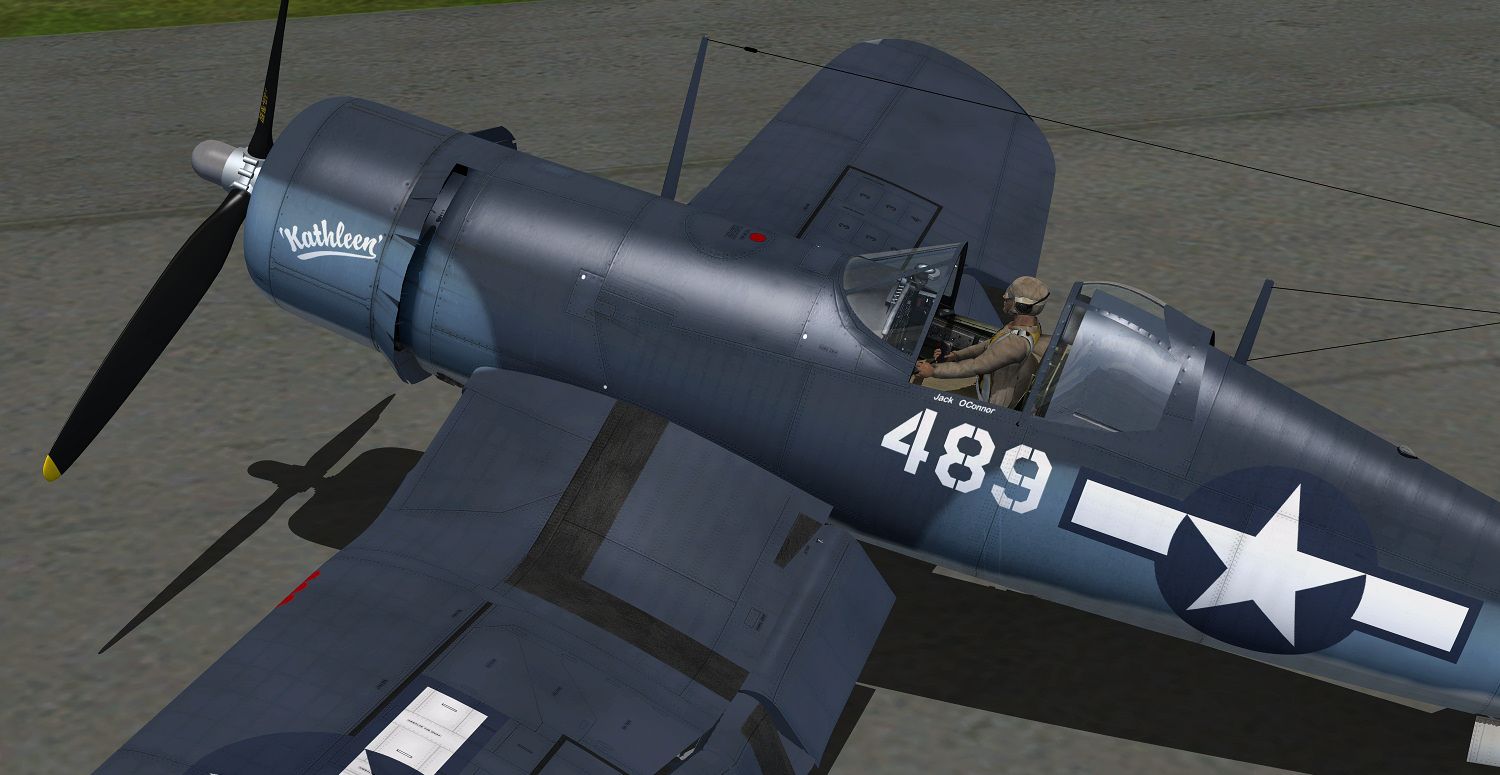
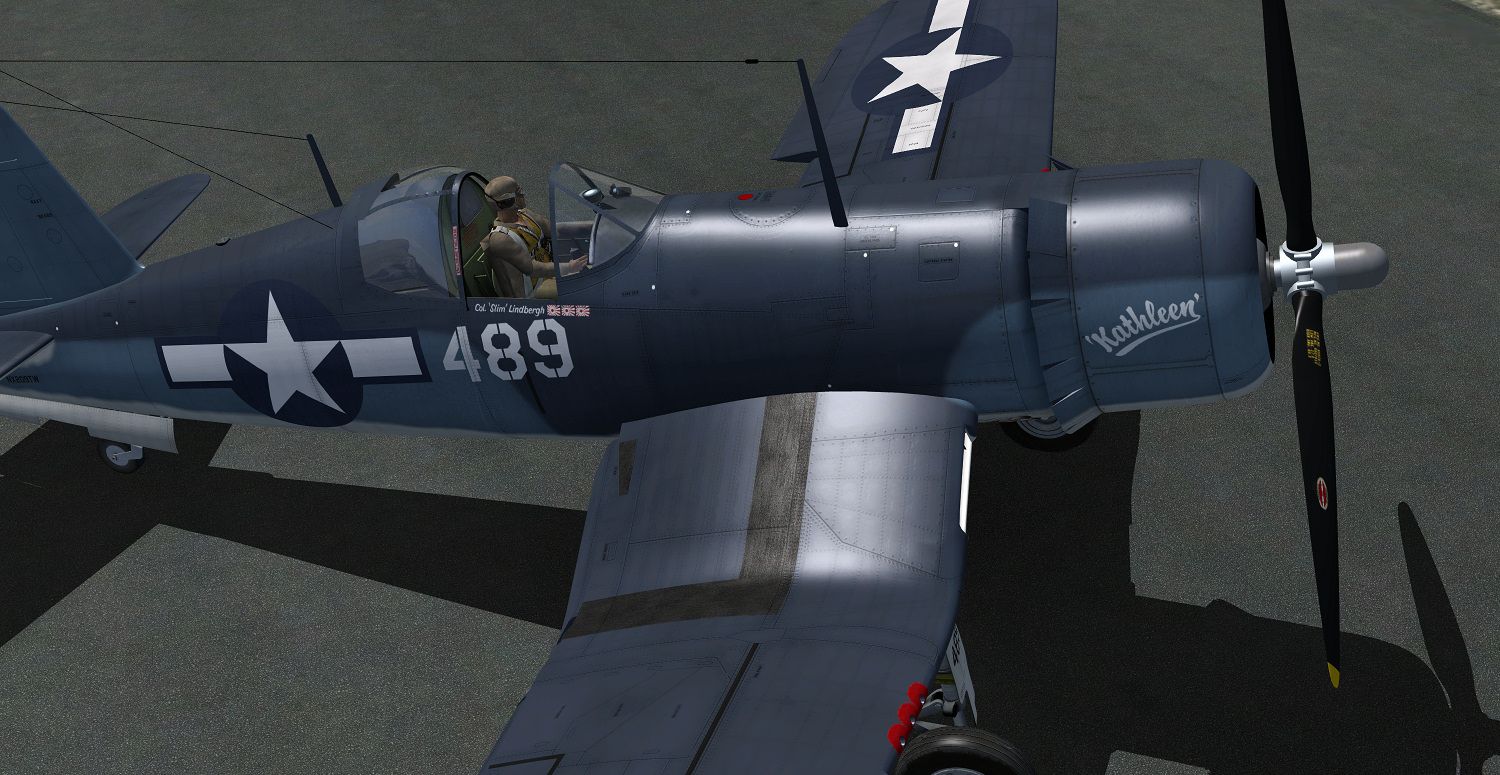
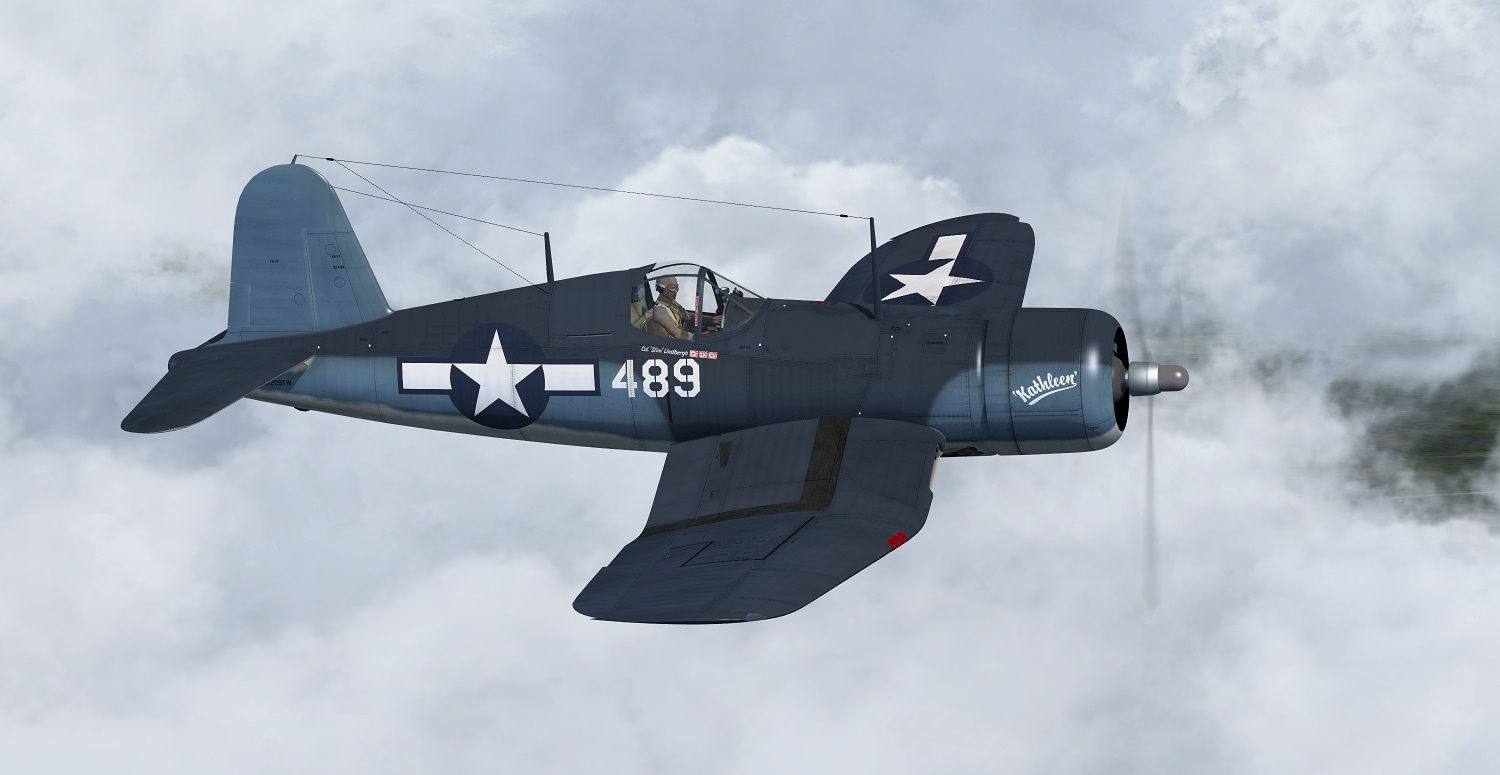
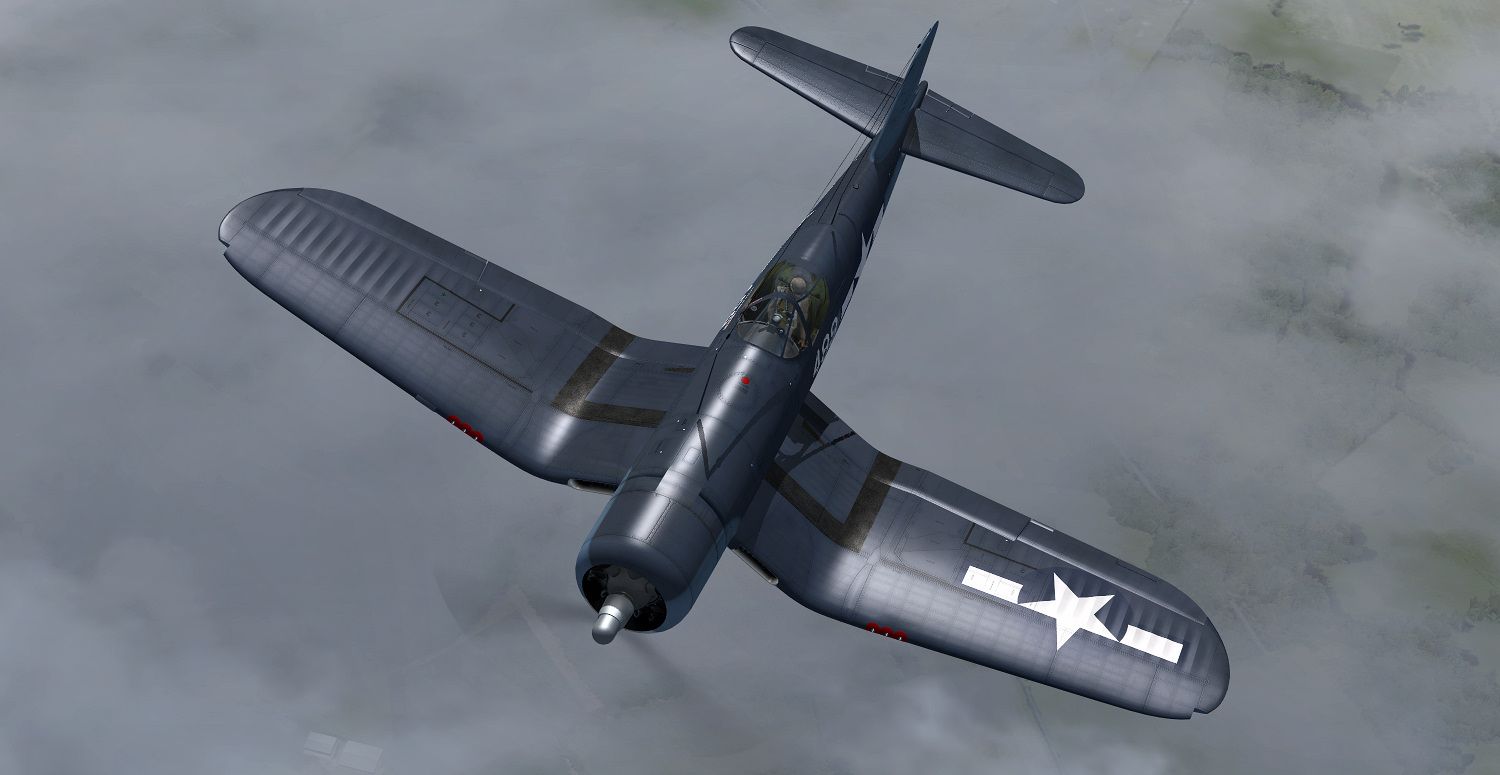
This repaint set depicts Goodyear FG-1D Corsair BuNo. 92489, from its debut at Oshkosh in 2010 following the completion of its award-winning restoration, and through its various slight changes in the years since (4 different options in all). This aircraft's survival is due to the efforts of Frank Arrufat, who purchased the aircraft from the Salvadorian AF in 1972. Frank, who was 32 at that point, was an ex-Navy pilot and an up-and-coming junior airline pilot working for TWA. An ad in Trade-A-Plane provided the news of the sale of surplus Corsairs in El Salvador, and Frank was able to hitch a ride on one of his company's aircraft to Ilopango Airport in San Salvador to ascertain what was available. After inspecting all of the Corsair airframes available, Frank decided on what was the least worse off and most complete of the Corsairs, FAS 209 (all of the Corsairs were incomplete, many lacking engines and with their outer wings detached). Frank drew up a laundry list of parts that his Corsair was missing and over the next two years he traveled back and forth to visit the airport, and through the help of personnel from the Salvadorian AF, worked on scavenging the needed parts from the other Corsairs on the field. In early 1974, with all of the needed parts found, the aircraft was finally disassembled and shipped to the U.S. - after the last of the payments, Frank had a complete Corsair project for $4,000. Due to being busy with work and starting a family, Frank wasn't able to get started on restoring the Corsair until 1983, basing the project at Fabens airstrip, an agricultural field, in El Paso, Texas. Over the next 17 years, Frank invested roughly 6,500 man-hours to restore the Corsair to airworthy. In 2000, Frank retired and began looking at the possibilities of fast-tracking the project to completion, and decided to send the project to John Lane's company, Airpower Unlimited in Jerome, Idaho (experts in authentic Corsair rebuilds) for completion. The plan that Frank had for the aircraft was followed through with precision - although a late-built FG-1D, Frank wanted the aircraft to resemble an F4U-1A or a very early F4U-1D Corsair, from the late-1943 to early-1944 period, a time when Corsairs were earning their keep, operating from crude land bases in the South Pacific. The feeling at the time was that there wasn't a Corsair flying that truly captured the essence of those early combat F4U's, and that restoring BuNo. 92489 in this fashion would set it apart. The transfiguration meant incorporating visual cues such as a tri-color camouflage paint scheme, an early style double-braced canopy, a slightly different antenna arrangement, amongst other detail alterations (including the fitting of an early factory-built Brewster center-line bomb rack). In 2009, with the Corsair on the verge of completion, Frank was faced with the hard fact that he was no longer able to justify spending more money on the project, and was willing to entertain offers from willing investors. Of a number of potential buyers, John O'Connor was the one to purchase the aircraft. Having fallen in love with the aircraft after having been introduced to the project in 2009, he set about having it completed just as Frank had intended, even including the name Kathleen on the nose, in honor of Frank's wife, and the registration number N209TW signifying FAS number 209 and Frank's previous employer, Trans World Airlines.
The plan from the moment John O'Connor purchased the aircraft was to have it completed in-time to debut at Oshkosh Airventure in 2010. Airpower Unlimited literally labored on the aircraft until the last moment to get the aircraft ready in time. With just enough flight testing conducted, John Lane headed to Oshkosh on the Monday of the show, but ran into a couple of engine problems upon nearing the first stop on the flight there. Waiting on a part, it wasn't until two days later that John Lane was able to make it into Oshkosh, late in the day, where Frank Arrufat and his wife Kathy were expectantly waiting as it rolled up in the warbird parking - when it showed up, it was a major surprise for those at the show and for those following the warbird forums at the time. Arriving just before the warbird judging was completed, the aircraft took home that year's World War Two Grand Champion award (amongst some stiff competition).
For the first version of this repaint, here is a depiction of what the aircraft looked like following completion of restoration by Airpower Unlimited and debuting at Oshkosh 2010. In this first stage, the aircraft was painted with the name "Kathleen" on the nose (Frank Arrufat's wife). It had "Jack O'Connor" painted along the canopy rail on the port-side (the aircraft's then owner). It had "Capt. "Slim" Lindbergh" and three Japanese flags painted along the canopy rail on the starboard side - this being to honor Charles Lindbergh and his involvement with Corsairs (and P-38's) in the Pacific - improving their endurance, and even tangling with the Japanese as a civilian pilot, with at least one confirmed 'kill' to his credit, having taken part in over 50 combat missions in the South Pacific. The aircraft's identifier number 489 comes from the last three digits of the actual airframe's BuNo. Although the markings are fictional, they are done in an absolute authentic manner, and the aircraft has one of the most authentic finishes of any warbird flying today. The tri-color paint scheme, for instance, was done based on original wartime guidelines for the era chosen. Where-as most all depictions of the tri-color scheme has intermediate blue on the lower surfaces of the outer wings, the original wartime guidelines that Airpower Unlimited sourced from the period of late-1943 and early-1944, they outlined that the lower surfaces of the outer wings were painted the same as the dark top-coat, non specular sea blue.
I really wanted to make sure the colors and tones were a very good/accurate match to the real aircraft, when seen in the sim, as compared to photographs of the real thing - this is something that can easily be way off (i.e., too much or too little saturation, too light or too dark from one color to the next, etc.). Also, just about every stencil is reproduced as per the real thing, and all of the white dots you see (as you do on the real thing) are inspection stamps, as applied at the factory. In this early stage, the propeller dome was clearly painted light grey, where as the rest of the propeller hub was bare metal.






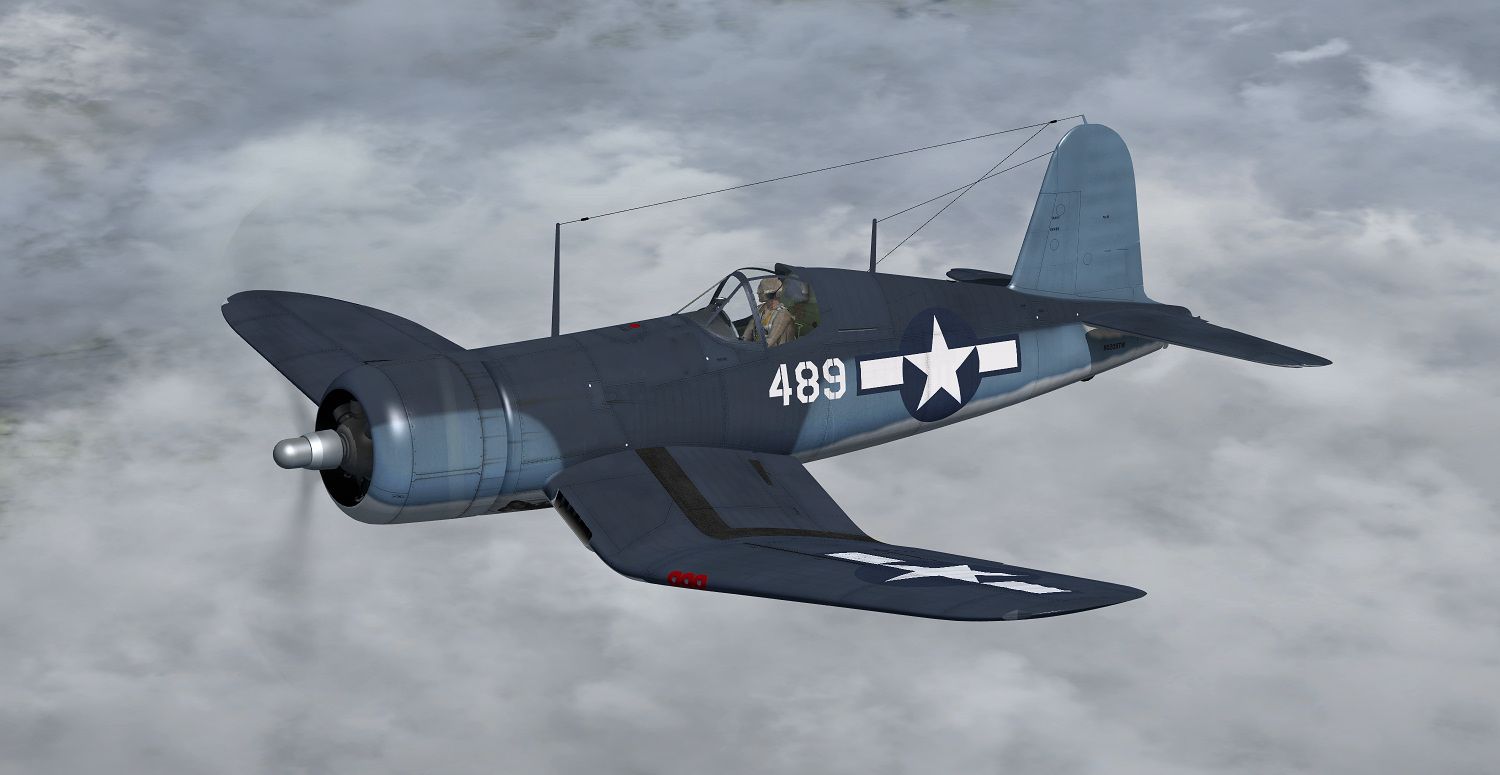
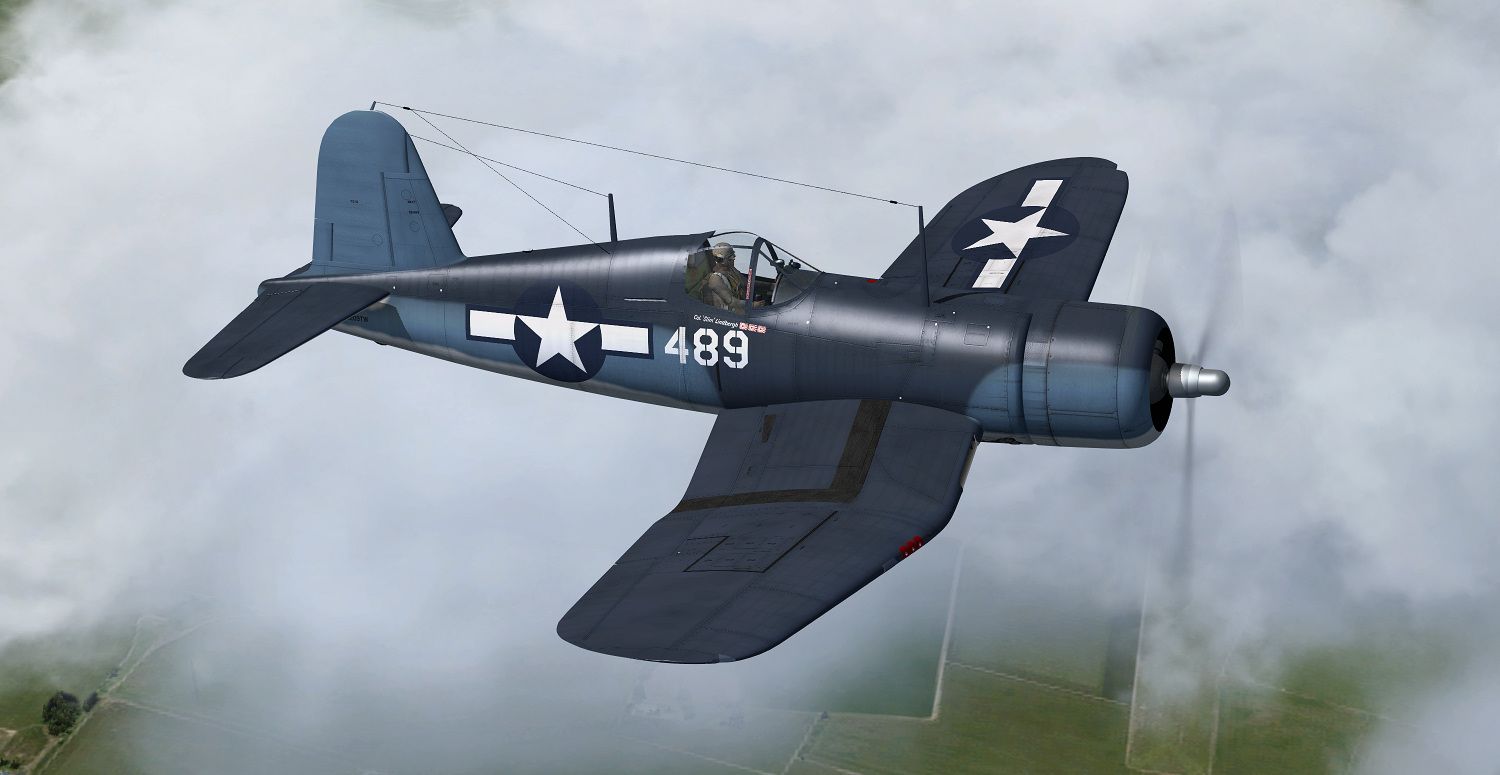
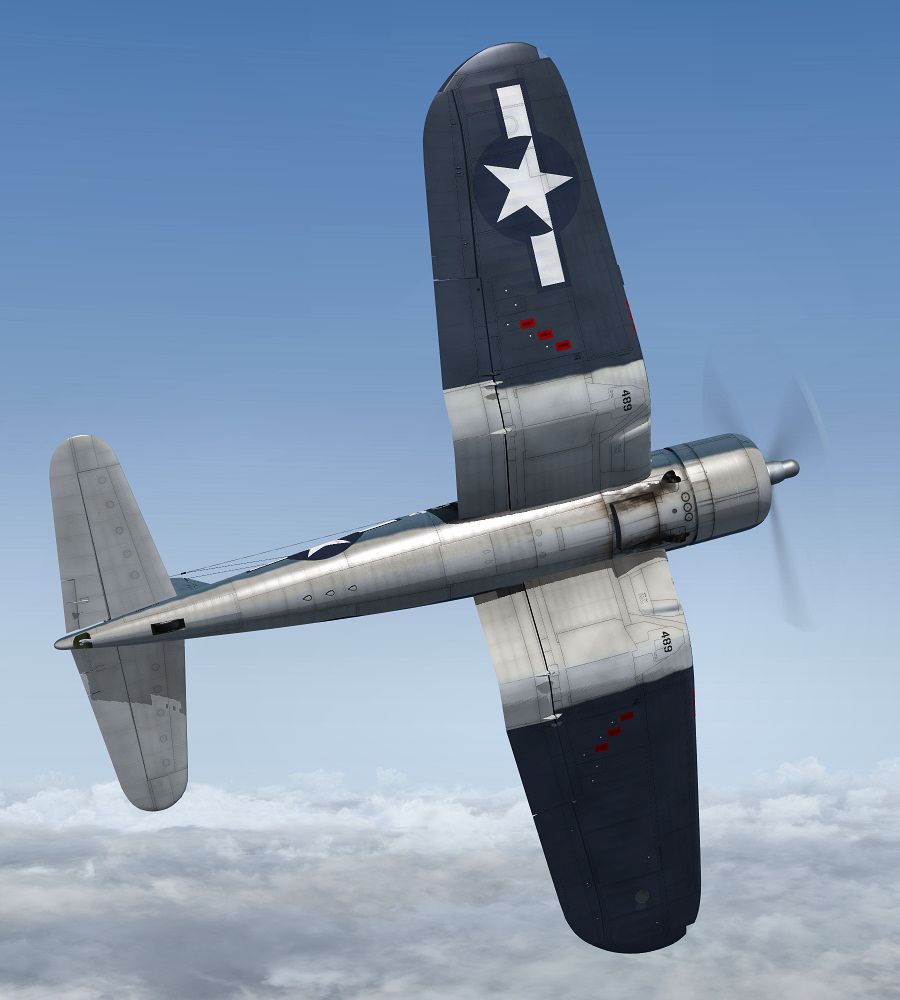
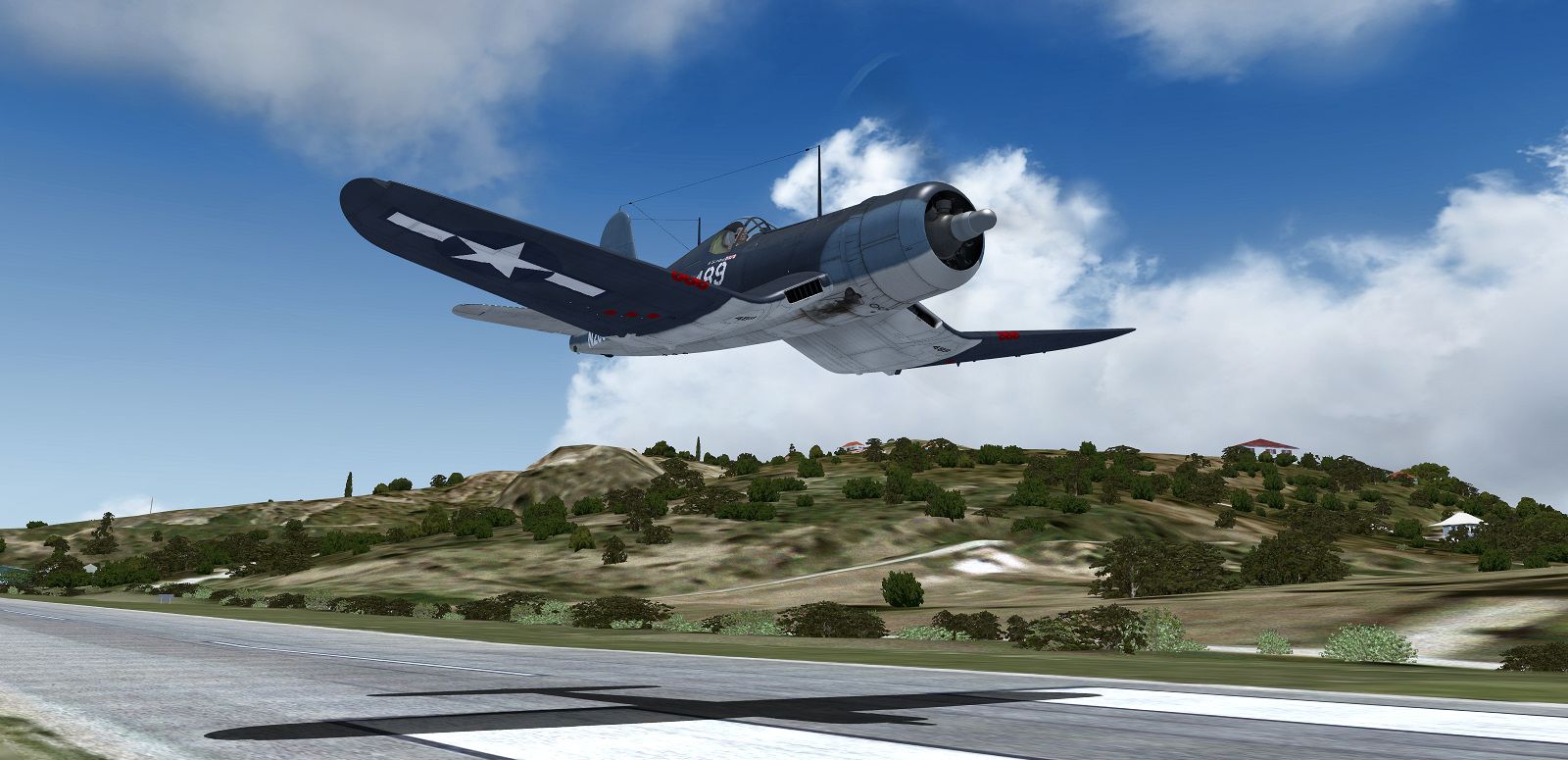
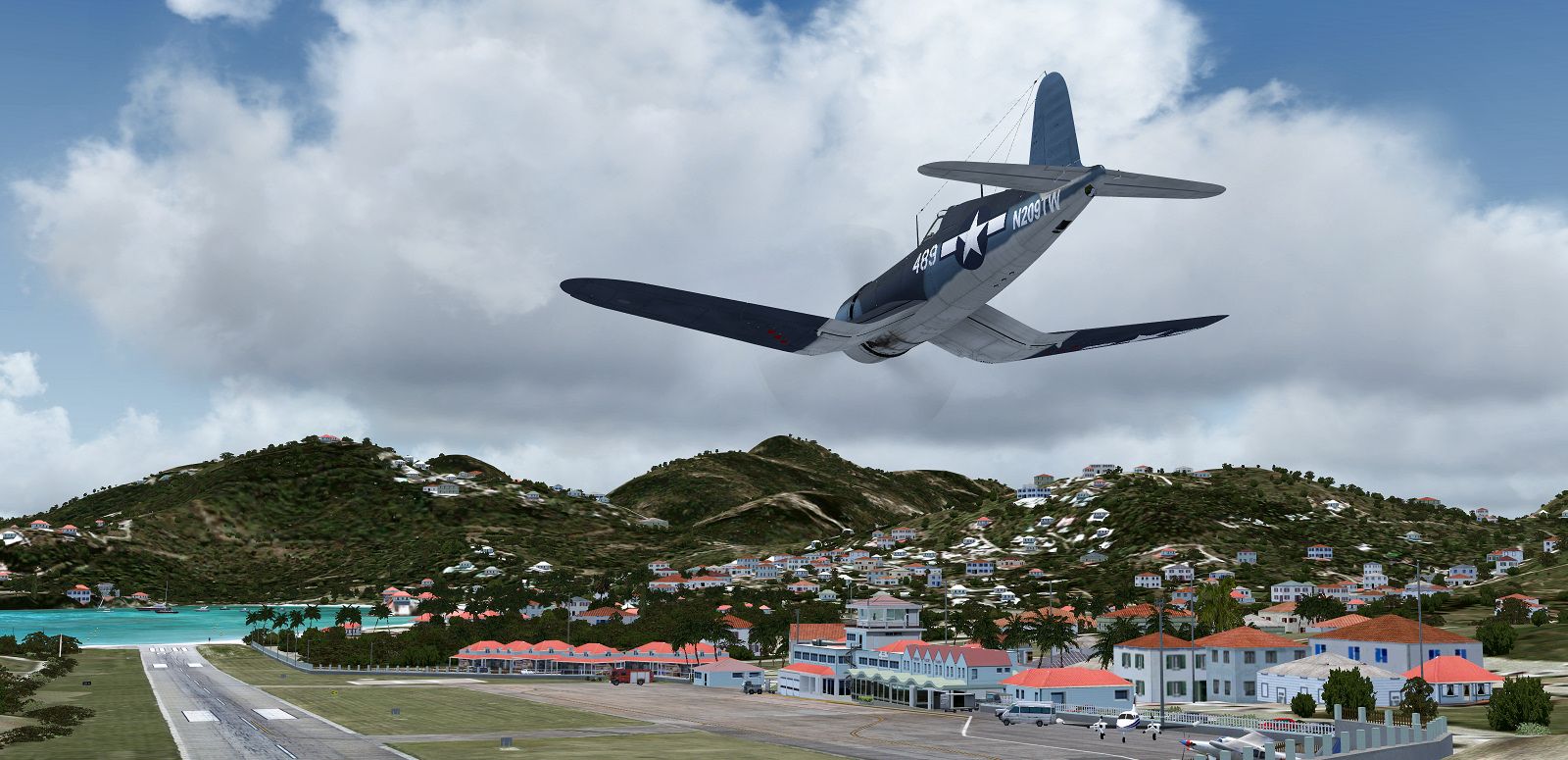
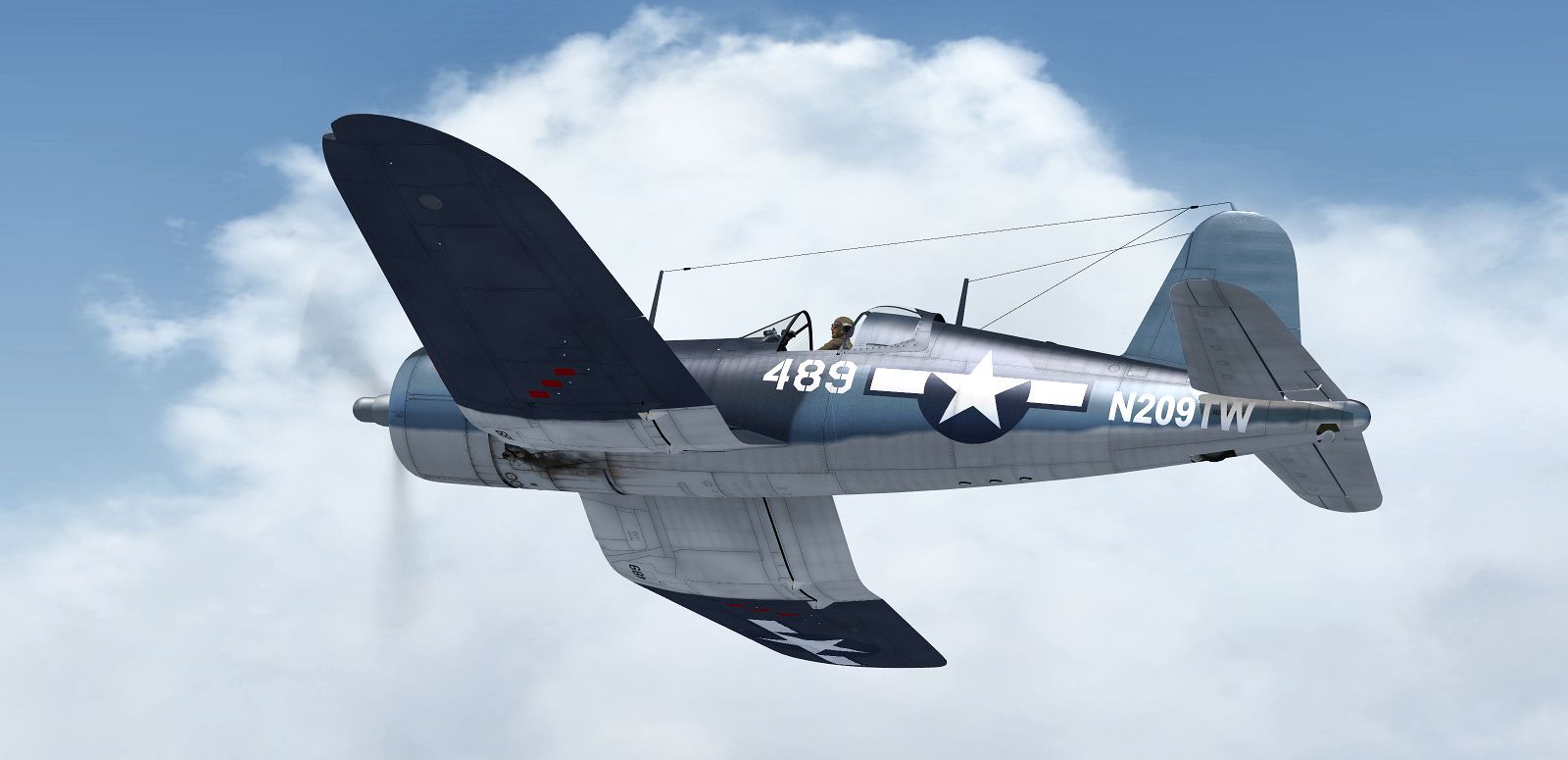
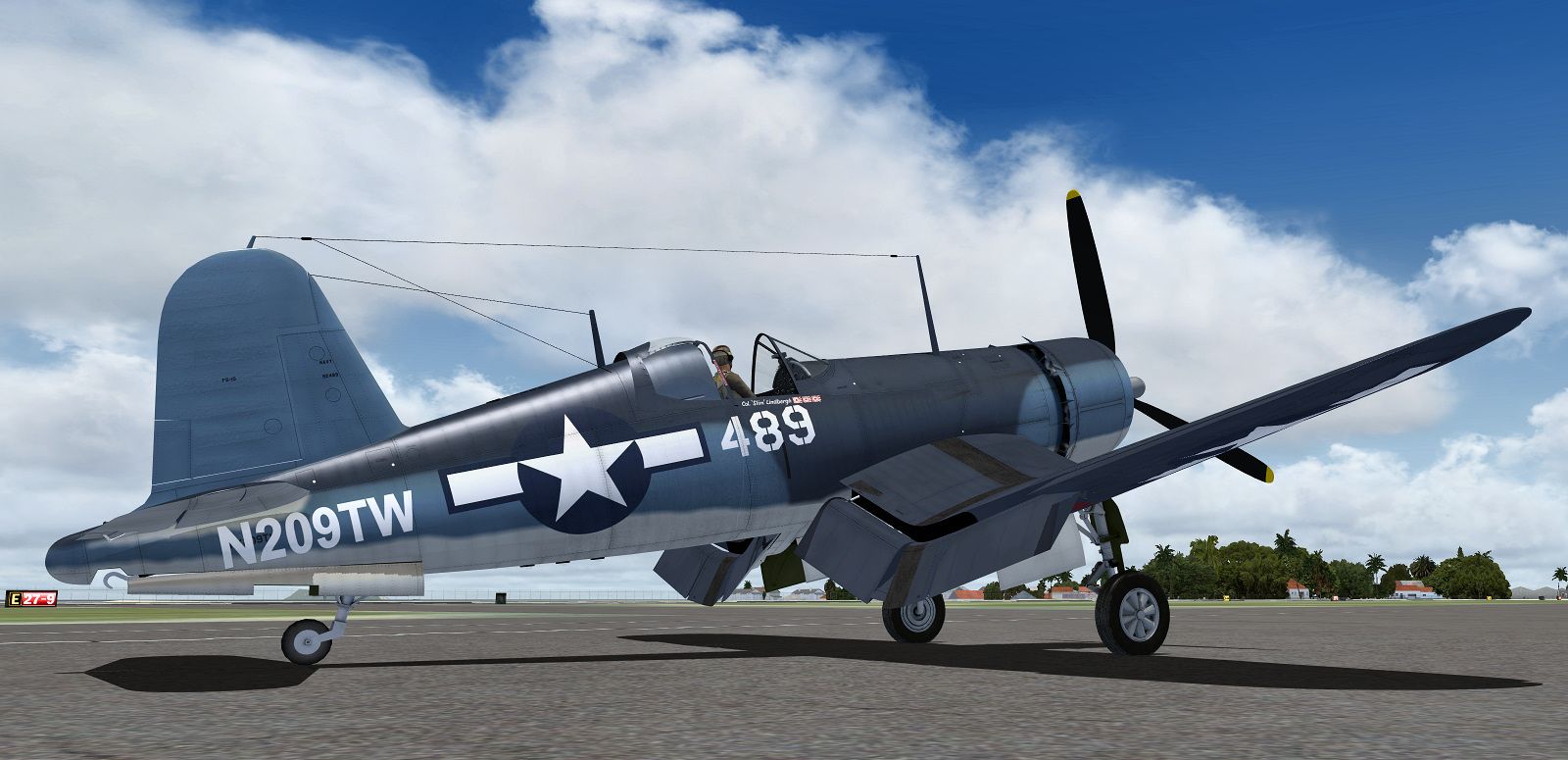




 )
)